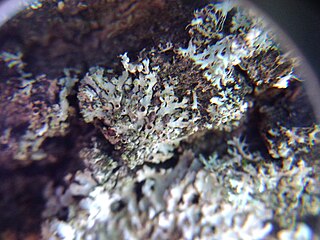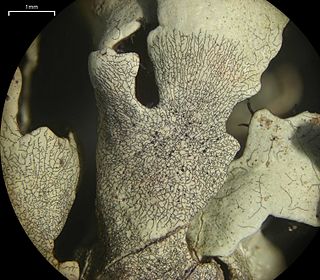
Aspicilia is a genus of mostly crustose areolate lichens that grow on rock. Most members have black apothecia discs that are slightly immersed in the areolas, hence the common name"Given the same reason, the naming of Aspicilia is derived from the Greek word for "shield concave".

The Lecanoraceae are a family of lichenized fungi in the order Lecanorales. Species of this family have a widespread distribution.

The Pertusariales are an order of fungi in the class Lecanoromycetes, comprising 8 families, 31 genera, and over 600 species, many of which form lichens. This diverse group is characterized by complex taxonomic history and ongoing phylogenetic revisions. Originally proposed by Maurice Choisy in 1949 and later formally published by the lichenologists David L. Hawksworth and Ove Eriksson in 1986, Pertusariales has undergone significant reclassification due to molecular phylogenetics studies. The order includes well-known genera such as Pertusaria and Ochrolechia, as well as families like Megasporaceae and Icmadophilaceae.

The Pertusariaceae are a family of lichen-forming fungi in the order Pertusariales.

Lichenochora is a genus of fungi in the family Phyllachoraceae. It has 44 species. All species in the genus are lichenicolous, meaning they grow parasitically on lichens. The genus was circumscribed by Josef Hafellner in 1989, with Lichenochora thallina assigned as the type species.

Psoroglaena is a genus of lichen-forming fungi in the family Verrucariaceae. The genus was circumscribed by Johann Müller Argoviensis in 1891, with Psoroglaena cubensis assigned as the type species.

Gyalidea is a genus of crustose lichens in the family Gomphillaceae. It has 50 species.

Lichenostigma is a genus of fungi in the family Phaeococcomycetaceae. It includes several species which are lichenicolous. The genus was circumscribed in 1983 by the Austrian mycologist Josef Hafellner, with Lichenostigma maureri assigned as the type species.

Circinaria is a genus of crustose lichens in the family Megasporaceae. It was circumscribed by Johann Heinrich Friedrich Link in 1809.

Lobothallia is a genus of lichens in the family Megasporaceae. Species in the genus have foliose thalli that become crustose areolate in the center with age, and grow on calcareous to siliceous rocks. The crustose part of the body may keep its lower cortex, though not always. Dark brown to black apothecia may be sunken into the surface of the thallus, as indicated in the common name puffed sunken disk lichen. Members grow to 3–5 cm (1.2–2.0 in) or more radiating lobes (placodioid). The photobiont is green alga from the genus Trebouxia. The genus is represented in Eurasia, Asia, North Africa, Central America, western North America, and Australia.

Megaspora is a genus of lichen-forming fungi in the family Megasporaceae. It contains four species of crustose lichens that typically grow on soil, bryophytes, or plant litter on chalky substrates.
Teuvoa is a genus of lichen-forming fungi in the family Megasporaceae. It was first classified by lichenologists Mohammad Sohrabi and Steven Leavitt in 2013, with Teuvoa uxoris assigned as the type species. This genus was delineated from the larger genus, Aspicilia, following a molecular phylogenetic analysis which revealed that the Aspicilia uxoris species group constituted a distinct lineage in the Megasporaceae. Initially containing three species, two additional species native to China were added in 2018. Teuvoa is characterised by its small ascospores and conidia, and the absence of secondary metabolites.
Eiglera is a small genus of crustose lichens belonging to the monotypic family Eigleraceae. Eiglera species are found in Europe and Northern America.
Alfred Mycolayovych Oxner was a Ukrainian botanist and lichenologist. His research covered various areas: floristics, taxonomy, phylogenetics, phytogeography, and phytosociology. Oxner founded the National Lichenological Herbarium of Ukraine.

Sarrameanaceae is a family of lichen-forming fungi in the monotypic order Sarrameanales. It contains the genera Loxospora and Sarrameana, the type genus. The genus Chicitaea was proposed in 2024 to contain Loxospora species containing 2'-O-methylperlatolic acid. The family was circumscribed by Josef Hafellner in 1984. The order Sarrameanales was proposed by Brendan Hodkinson and James Lendemer in 2011, as they had noted that previously published large-scale molecular phylogenetic studies had shown that the group of species contained in the family Sarrameanaceae were distinct and separate from the clade containing all of the other orders of the Ostropomycetidae. However, the name Sarrameanales was not validly published according to the rules of botanical nomenclature, because it was not accompanied by a suitable description. Despite this, the order continues to be used in lichenological literature.
Claude Roux is a French lichenologist, mycologist and Esperantist. He has co-authored books about the identification of lichens written in Esperanto.
Oxneriaria is a genus of lichen-forming fungi in the family Megasporaceae. It has nine species, all of which are saxicolous (rock-dwelling), crustose lichens. The genus was circumscribed in 2017 by Sergey Kondratyuk and László Lőkös to contain species formerly in the Aspicilia mashiginensis species group. This species, now the type of the genus, was first described scientifically by Alexander Zahlbruckner as Lecanora mashiginensis. The genus name honours Ukrainian lichenologist Alfred Oxner, who, according to the authors, "provided important contribution [sic] to taxonomy of aspicilioid lichens and to biodiversity of polar lichens".
Circinaria mansourii is a species of terricolous (ground-dwelling) crustose lichen in the family Megasporaceae. It is primarily found on soil or plant debris in Iran, particularly in the mountainous steppe-like habitats. It was described as new to science in 2011.

Aspiciliella is a genus of lichen-forming fungi in the family Megasporaceae. It has four species. The genus is characterised by its crustose, rimose-areolate thallus that is partially continuous and has a K+ (red) reaction. The epihymenium is typically green to olive-green and turns light green when treated with N. Aspiciliella has eight-spored asci of the Aspicilia-type, containing ellipsoid, colourless, and simple ascospores.













